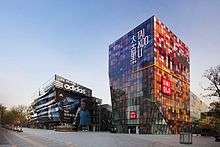Taikoo Li Sanlitun
Taikoo Li Sanlitun (Chinese: 三里屯太古里; pinyin: Sānlǐtún Tàigǔlǐ), formerly Sanlitun Village, is a shopping center in the Sanlitun area of the Chaoyang District in Beijing, China. It comprises 19 buildings on two sites that are a few minutes walk from each other. Besides retail space, the project includes a 99-room boutique hotel, The Opposite House (瑜舍).

Location
Taikoo Li Sanlitun is adjacent to Beijing Subway Line 2 Dongsi Shitiao Station and Line 10 Tuanjiehu Station. Dongdaqiao Station on Line 6 is also close by. It is a ten-minute walk from Tuanjiehu, a twenty-minute walk from Dongsi Shitiao and a twenty-minute walk from Dongdaqiao. It is recommended to take Exit A or D from Tuanjiehu.
History and construction
The center opened in July 2008, and is developed and managed by Hong Kong-based Swire Properties (Taikoo Properties). It comprise two sites:[1]
- The Piazza (Taikoo Li South)
The center opened in July 2008, and contains 260+ stores, dining outlets and services including a multi-screen theatre.
- The Deck (Taikoo Li North)
The area includes a large number of stores, especially fashion brands. It also includes art galleries focusing on avant-garde and contemporary Chinese and foreign artists.[2][3][4]
Design
It was designed by a group led by the Oval partnership from Hong Kong, and Japanese architect Kengo Kuma (隈 研吾).[5][6]
The design of Taikoo Li South is inspired by Beijing's hutongs, while Taikoo Li North draws its courtyard form from China's siheyuan.[5] The space also includes modern pieces such as an open fountain and little touches from contemporary artists.[7][8]
References
- "Design Concept".
- About Sanlitun Village
- (in Chinese)
- (in Chinese)
- "Design Concept".
- "Design and Architecture".
- in Chinese
- (in Chinese)
External links
| Wikimedia Commons has media related to Taikoo Li Sanlitun. |